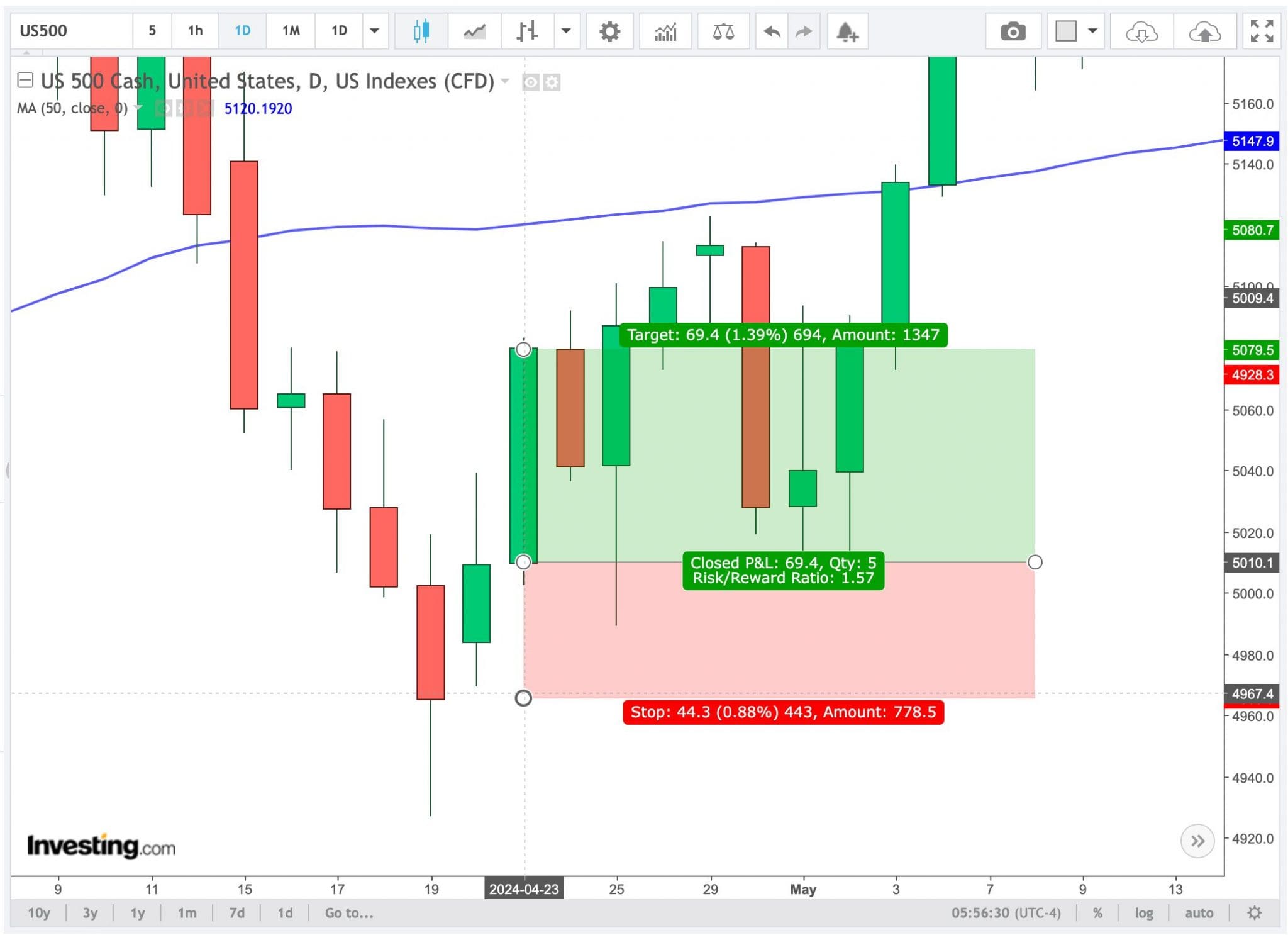Day Trading in the US



Day trading in the US is a fast-paced and high-risk form of trading where you buy and sell financial instruments within the same day, aiming to capitalize on small price fluctuations to make profits.
The US stock market is the largest globally, with daily volumes over $2 billion, the dollar is involved in around 88% of forex trades, while the country’s $28 trillion economy provides a broad backdrop for active traders.
Ready to start day trading in the US? This guide for beginners will get you started.
Quick Introduction
- The Securities and Exchange Commission (SEC) and Financial Industry Regulatory Authority (FINRA) primarily oversee securities, while the Commodity Futures Trading Commission (CFTC) supervises derivatives. All are ‘green tier’ bodies in DayTrading.com’s Regulation & Trust Rating, enforcing stringent rules to protect US traders.
- The Pattern Day Trader (PDT) rule, implemented by the SEC and FINRA, requires traders in the US with less than $25,000 in their margin account to limit their day trades.
- The US hosts the world’s two largest stock exchanges: the New York Stock Exchange (NYSE) and NASDAQ. The NYSE is renowned for its blue-chip companies, while the NASDAQ is known for its tech-heavy listings. Additionally, the Chicago Board Options Exchange (CBOE) is a leading market for options and futures trading.
- In the US, day traders typically pay short-term capital gains taxes at ordinary income rates, ranging from 10% to 37%, with payments made to the Internal Revenue Service (IRS).
Top 4 Brokers in the United States
After testing around 500 platforms, these 4 regulated brokers stand out as the best for day traders in the US:
-
1
 eToro USARegulated by: SEC, FINRAInvest $100 and get $10https://www.daytrading.com/ is not an affiliate and may be compensated if you access certain products or services offered by the MSB and/or the BD.
eToro USARegulated by: SEC, FINRAInvest $100 and get $10https://www.daytrading.com/ is not an affiliate and may be compensated if you access certain products or services offered by the MSB and/or the BD.
Ratings/ 5/ 5/ 5/ 5/ 5/ 5/ 5/ 5/ 5/ 5
$10$10SEC, FINRAStocks, Options, ETFs, CryptoeToro Trading Platform & CopyTraderACH Transfer, Debit Card, PayPal, Wire TransferUSD -
2
 Interactive BrokersRegulated by: FCA, SEC, FINRA, CFTC, CBI, CIRO, SFC, MAS, MNB, FINMA, AFM
Interactive BrokersRegulated by: FCA, SEC, FINRA, CFTC, CBI, CIRO, SFC, MAS, MNB, FINMA, AFM
Ratings/ 5/ 5/ 5/ 5/ 5/ 5/ 5/ 5/ 5/ 5
$0$1001:50FCA, SEC, FINRA, CFTC, CBI, CIRO, SFC, MAS, MNB, FINMA, AFMStocks, Options, Futures, Forex, Funds, Bonds, ETFs, Mutual Funds, CFDs, CryptocurrenciesTrader Workstation (TWS), IBKR Desktop, GlobalTrader, Mobile, Client Portal, AlgoTrader, OmniTrader, eSignal, TradingCentralCheque, ACH Transfer, Wire Transfer, Automated Customer Account Transfer Service, TransferWise, Debit CardUSD, EUR, GBP, CAD, AUD, INR, JPY, SEK, NOK, DKK, CHF, AED, HUF -
3
 MoomooRegulated by: SEC, FINRA, MAS, ASIC, SFCGet up to 15 free stocks worth up to $2000
MoomooRegulated by: SEC, FINRA, MAS, ASIC, SFCGet up to 15 free stocks worth up to $2000
Ratings/ 5/ 5/ 5/ 5/ 5/ 5/ 5/ 5/ 5/ 5
$0$01:2SEC, FINRA, MAS, ASIC, SFCStocks, Options, ETFs, ADRs, OTCsDesktop Platform, Mobile AppWire Transfer, ACH TransferUSD, HKD, SGD -
4
 EmpowerRegulated by: SEC, FINRA
EmpowerRegulated by: SEC, FINRA
$1 (Cash), $100,000 (Robo Advisor)VariableSEC, FINRAStocks, ETFs, Mutual Funds, Fixed IncomeOwnWire TransferUSD
Day Trading Platforms in the US
What Is Day Trading?
Day trading refers to the buying and selling of financial instruments within the same day. All positions are closed before the market closes, and no positions are held overnight to avoid negative price gaps and holding fees.
Day traders typically use leverage to magnify results (profit and loss) and short-term trading strategies to capitalize on small price movements in highly liquid assets.
US traders have access to a wide array of highly liquid, volatile markets, both domestically and globally, that suit active trading styles, including:
- Stocks spanning the NYSE and NASDAQ, such as Apple and Meta, that are known for their massive daily trading volumes and large price swings.
- Indices like the S&P 500 (500 biggest companies listed in the US), Dow Jones (30 large, publicly traded firms) and Russell 2000 (tracks the performance of 2,000 smaller stocks).
- Commodities like West Texas Intermediate (WTI) crude oil, natural gas, corn, wheat and soybeans, given that the US is a huge producer globally.
- Forex trading in the US with the ‘major’ currency pairs all including the US dollar (EUR/USD, USD/JPY, GBP/USD, USD/CHF, USD/CAD, AUD/USD, NZD/USD), exhibiting significant trading volumes.
Is Day Trading Legal In The US?
Day trading is legal in the US and supervised by some of the most stringent regulations globally that are designed to protect investors and maintain market stability.
The SEC, FINRA and CFTC are the primary regulatory bodies overseeing short-term trading activities, ensuring a secure and fair trading environment.
One key regulation is the PDT Rule. According to this, if you execute four or more day trades within five business days in a margin account, you are classified as a Pattern Day Trader.
To continue day trading under this classification, you must maintain a minimum account balance of $25,000. If your account falls below this threshold, you will be restricted from day trading until the balance is restored.
You must also follow the rules related to margin trading. The Federal Reserve’s Regulation T (Reg T) permits you to borrow up to 50% of the purchase price of securities on margin. Still, you are often subject to stricter margin requirements to mitigate the risks of your frequent trading.
How Is Day Trading Taxed In The US?
Trading taxes in the US depend on the holding period of your investments.
Short-term capital gains – profits from assets held for one year or less – are typically taxed by the Internal Revenue Service (IRS) at ordinary income tax rates ranging from 10% to 37%, depending on your income bracket.
Long-term capital gains for assets held longer than a year are taxed at lower rates of 15% or 20%.
Day traders typically pay higher short-term capital gains tax rates. However, you may deduct certain expenses if you qualify for Trader Tax Status (TTS).
Since trading taxation in the US is complex and evolving, I recommend consulting a local tax professional to ensure compliance with all applicable tax laws and that returns are submitted on time (15 April the following year).
Getting Started
Starting day trading in the US can be a straightforward process when broken down into three steps:
- Choose a top US day trading platform. Prioritize a brokerage regulated in the US, low trading fees as costs can cut into profits for frequent traders, and user-friendly charting platforms with advanced tools and real-time data. Also look for excellent educational materials if you’re a beginner and a demo account to test strategies before depositing any dollars.
- Set up your account. You must complete an online application by providing personal and financial information. You’ll also need to verify your identity by submitting supported documents, such as a copy of your State ID Card or Social Security Card, and proof of address. Finally, you’ll need to review and accept the broker’s terms and conditions before you can start online trading.
- Deposit US dollars. Once your account is approved, you can fund it using your preferred payment method, such as a debit card, Automated Clearing House Transfer (ACH), or Automated Customer Account Transfer Service (ACATS). Also consider using a USD trading account (offered by over 95% of the brokers we’ve evaluated). This can reduce currency conversion fees and simplify your accounting and tax reporting.
A Day Trade In Action
Let’s consider a scenario where I day trade the S&P 500, an index tracking the stock performance of 500 of the largest US companies listed on stock exchanges.
The S&P 500 is popular with short-term traders due to its high liquidity, volatility, and representation of the broader US economy.
Event Background
Gold prices sharply dropped approximately 1.95% in a single day, its most significant daily loss in a few years.
Historically, when gold prices fall, investors tend to move away from safe-haven assets like gold and into riskier assets such as equities, causing the S&P 500 to rise.
I focused on the S&P 500 as it typically reacts to significant movements in the gold market.

Trade Entry & Exit
As the news about the gold market hit, I noticed a quick increase in the S&P 500, driven by initial uncertainty. However, as gold declined, investors began reallocating funds into equities, causing a shift in market sentiment.
I saw this as an opportunity to enter a long (buy) position on the S&P 500. I anticipated the index would rally as capital flowed from gold and into stocks.
Once the trading session following the sharp decline in the price of gold opened, I entered a long position at 5,010. As expected, the index began to climb steadily throughout the day, increasing buying volume and further validating my decision.
I didn’t set a target price because I planned to hold the trade open for the entire day and close it manually near the end of the US trading session. I didn’t want to hold the trade overnight due to volatility and overnight fees.
I set a stop near the low of the previous trading day, risking 0.88% to make 1.39%.
Noticing a slight weakening in momentum, I decided to exit my position just before the final hour of the US trading session, securing my profits before any potential pullback could occur.
This trade highlighted the impact that commodity markets, like gold, can have on the broader equity market.I capitalized on the S&P 500’s reaction to movements in the gold market, demonstrating the interconnectedness of global financial markets.
Bottom Line
Day trading in the US is legal but highly regulated, overseen by the SEC and FINRA.
Rules like PDT require a minimum account balance of $25,000 for frequent traders. Short-term traders often use margin accounts, facing stricter requirements due to the risks involved.
Profits from day trading are typically taxed as short-term capital gains at ordinary income rates. However, you may benefit from additional tax deductions if you qualify for TTS.
Despite its profit potential, active trading in the United States demands a deep understanding of financial markets, quick decision-making, disciplined risk management, and strict compliance with the latest regulations. Also be aware you could lose all the money you invest.
To get started, see DayTrading.com’s selection of the best US brokers for day trading.
Recommended Reading
Article Sources
- Financial Industry Regulatory Authority (FINRA)
- Securities and Exchange Commission (SEC)
- US Equities Market Volume Summary - Cboe
- US GDP - International Monetary Fund
- Chicago Board Options Exchange (CBOE)
- New York Stock Exchange (NYSE)
- NASDAQ
- Internal Revenue Service (IRS)
- Pattern Day Trader - FINRA
- World Gold Council
- List of Countries by Stock Market Capitalization - Wikipedia
- Regulation T (Reg T) - Investopedia
- US Taxes on Personal Income - PWC
- Trader Tax Status (TTS) - Forbes
The writing and editorial team at DayTrading.com use credible sources to support their work. These include government agencies, white papers, research institutes, and engagement with industry professionals. Content is written free from bias and is fact-checked where appropriate. Learn more about why you can trust DayTrading.com